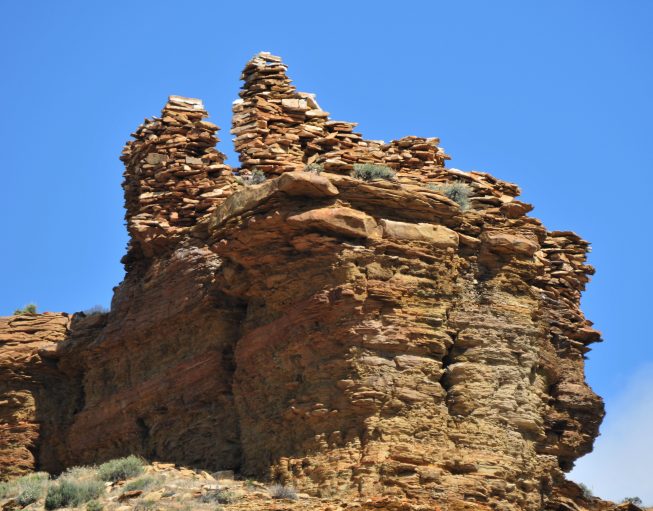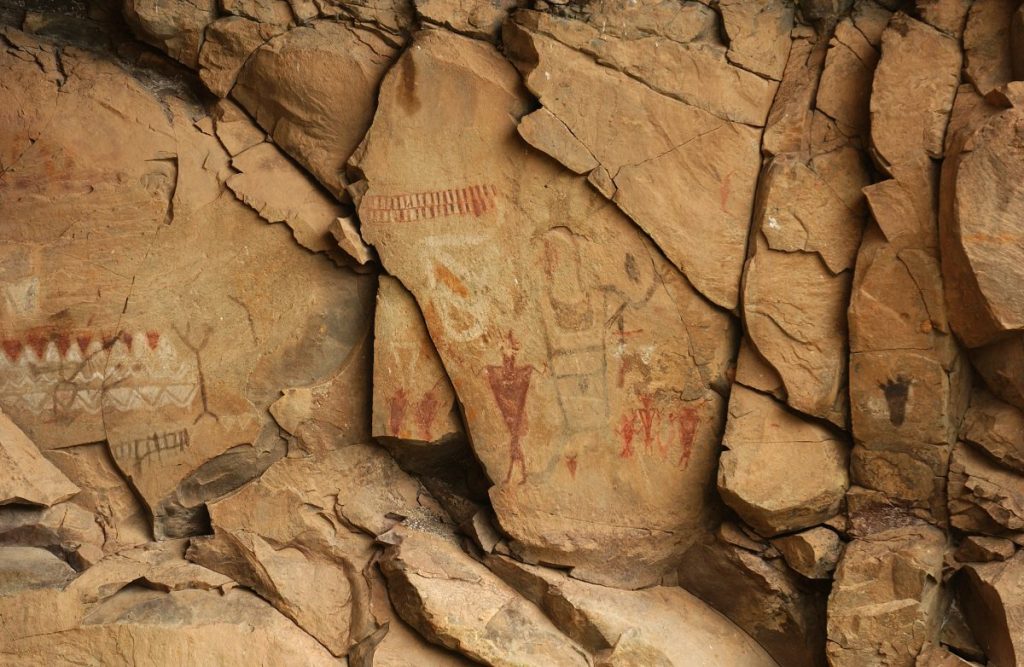
The stone tower at Fort Rocking Chair (ET6-13), seen on April 28, 2017. (Photo by Dan Bauer.)
By Jerry D. Spangler
I was a bumbling first-year graduate student when I stumbled upon my first Claflin-Emerson Expedition site in the spring of 1989 in Nine Mile Canyon. It was a fascinating site: a series of round, semi-subterranean pit houses on a bench overlooking the valley floor. Below one pit-house floor, we excavated the burial of a child, an arrow point lodged in the chest area.[1]Radiocarbon dates later showed that these were homes of the ancient Fremont peoples, farmers and foragers who thrived in the Tavaputs Plateau region from AD 900 to 1250.
At the time, I did not know that it was one of the many sites the Claflin-Emerson team first visited in 1931 in Nine Mile—no one did—because we did not have access to their 1931 field journals and they never published a report. And James Gunnerson’s 1969 summary of those sites offered only vague clues as to their location. During the course of the next three summers, I inadvertently stepped onto at least ten of their sites, not knowing that Peabody Museum scholars had trod there more than a half century before.
I didn’t think much about the 1931 expedition in the years that followed, although my love for the history of Utah archaeology in general continued to mature. In 2002, I happened to be invited, along with Duncan Metcalfe, archaeology curator at the Natural History Museum of Utah, and Kevin Jones, then the Utah state archaeologist, to visit archaeological sites in Range Creek. We knew that the Claflin-Emerson Expedition had been there in July 1931, and we figured out some of the sites they had visited, in spite of the limited information Gunnerson had offered.
Sitting around the Range Creek campfire at nights, we spun out this idea: What did the Peabody Museum at Harvard actually have in its collection that would help us better understand the archaeology of Range Creek? And would they be willing to share that information with us?
Over the next few years, I made three trips to the Peabody Museum (2005, 2005, and 2007) to work closely with museum staff to identify not just information relevant to Range Creek but to the entire West Tavaputs Plateau. This began a long and fruitful relationship with Patricia Kervick, senior archivist at the Peabody. Pat has been amazingly gracious and patient in providing me—and later my coauthor, Jim Aton—with copies of the five original 1931 field journals, of Donald Scott’s unpublished report summarizing the expedition, and more. I became thoroughly seduced by the words in those journals (long on archaeological data but short on interpersonal details), the sketches and photographs, and the sheer magnitude of what they had accomplished. But I was stunned to discover that Gunnerson’s summary, part of his PhD dissertation at Harvard, had omitted perhaps as much as 30 percent of all sites visited in 1931.[2] I was even more surprised to find the museum had hundreds of 1931 photographs, a good share of them of excellent quality and ideal for research purposes.
What started as a simple attempt to learn more about Range Creek quickly became an obsession: the journals and the photographs were a road map to re-identify every Claflin-Emerson site. I am sure my Range Creek colleagues rolled their eyes a time or two at my giddiness when I discovered yet another 1931 site. Within two years, I had identified, re-documented, and re-photographed all twenty-nine Claflin-Emerson sites in Range Creek.[3] A comparison of the 1931 photographs to current site conditions was part of a groundbreaking research paper on archaeological site degradation, written with my esteemed colleagues, Shannon Arnold and Joel Boomgarden.[4]
My fascination soon led me to search for Claflin-Emerson Expedition sites in Nine Mile and Desolation Canyon. And it was inevitable that my path would cross with Kentucky native James M. Aton, a kindred spirit and a fellow obsessive. Jim is a Fulbright scholar, an English professor at Southern Utah University, and an award-winning author. He wrote the definitive history of the Green River, The River Knows Everything: Desolation Canyon and the Green.[5] And he is just as passionate about the archaeological history of this wild land as I am. We have spent much of the past twelve years together retracing the steps of the Claflin-Emerson Expedition. This has meant numerous river trips in Desolation Canyon to find Claflin-Emerson sites in side canyons such as Chandler, Florence Creek, Jack Creek, and Rock Creek. We’ve made many road trips to Nine Mile Canyon, the Uinta Basin, Hill Creek, Willow Creek, and Dinosaur National Park to relocate sites. On top of all our field work, Jim traveled to Cambridge, Massachusetts, in June 2015 to work at the Peabody and the Pusey Library where he scanned close to a thousand pages of documents: receipts, planning charts, correspondence, and students records. We have also found and contacted four descendants of the expedition members or sponsors. All have enthusiastically supported our project and contributed photographs, memories, letters, and journals.
I am an archaeologist and Jim is a historian: a perfect combination of skills to tell the story of one of the most remarkable archaeological expeditions in American history. It is a tale of mostly privileged young men who, at first blush, would seem ill-suited to four hundred miles on horseback into the wildest canyon country imaginable, all in the name of science. The fact that they accomplished it without a scratch speaks to the perceived immortality of young men everywhere, not to mention their skill and planning.
But how to tell this story? Neither of us wanted to write a day-by-day travelogue, nor did we care to burden the reader with endless descriptions of rock art and granaries and the sometimes-spectacular architecture that dots this landscape. Although we necessarily must do some of that, we believe the story is rooted in the people: the scholars, the benefactors, the student participants, the guides and wranglers, the ranching families they met along the way, and those who walked these same lands before and after the Harvard boys’ seven-week sojourn here. This is a story about archaeology, and archaeology is, or at least it should be, a story about people.
The Claflin-Emerson Expedition was actually a four-year project from 1928 to 1931 that explored much of the Colorado Plateau north of the Colorado River. This article and the forthcoming book from which it is drawn focus primarily on the 1931 expedition—the last one and certainly the most ambitious of all. In fact, the 1931 expedition dwarfed those of the previous three years, not only in geographic scope but in logistical difficulty. What they did in the summer of 1931 has not been duplicated since. As contemporary researchers and adventurers, we stand in awe of their accomplishments.
Revisiting the Claflin-Emerson Sites
- The stone tower at Fort Rocking Chair (ET6-13), seen on April 28, 2017. (Photo by Dan Bauer.)
- Long-distance shot of ET6-26 in Lower Hill Creek, April 28, 2017. (Photo by Dan Bauer.)
- Gunnison Butte and Green River, January 27, 2018. (Photo by James M. Aton.)
- The stone tower at Fort Rocking Chair (ET6-13), seen on April 28, 2017. (Photo by Dan Bauer.)
- Rasmussen Cave, January 27, 2018. (Photo by James M. Aton.)
- Sand Wash Ferry site, January 27, 2018. (Photo by James M. Aton.)
- Rock art in Range Creek, July 30, 2006. (Photo by Dan Miller.)
- Desolation Canyon tower (ET5-1) near Peter’s Point. (Photo by James M. Aton.)
Notes
[1]. Patricia Thompson, “Excavations in Nine Mile Canyon from 1892–1990: A Study in Cultural Diversity,” (Master’s Thesis, Brigham Young University, 1993).
[2]. James H. Gunnerson, The Fremont Culture: A Study in Cultural Dynamics on the Northern Anasazi Frontier, Papers of the Peabody Museum of Archaeology and Ethnology 59, no. 2 (1969).
[3]. Jerry D. Spangler, K. Renee Barlow, and Duncan Metcalfe, “A Summary of the 2002–2003 Intuitive Surveys of the Wilcox Acquisition and Surrounding Lands, Range Creek Canyon, Utah,” Utah Museum of Natural History Occasional Papers 2004-1 (Salt Lake City: University of Utah, 2004).
[4]. Jerry D. Spangler, Shannon Arnold, and Joel Boomgarden, “Chasing Ghosts: A GIS Analysis and Photographic Comparison of Vandalism and Site Degradation in Range Creek Canyon, Utah,” Utah Museum of Natural History Occasional Papers 2006-1 (Salt Lake City: University of Utah, 2006).
[5]. James M. Aton, The River Knows Everything: Desolation Canyon and the Green (Logan, Utah: Utah State University Press, 2009).









